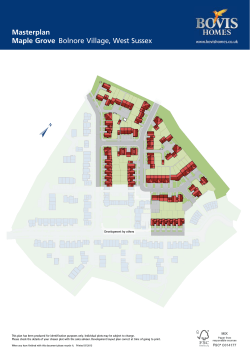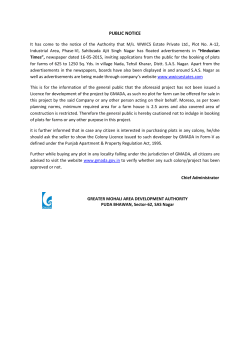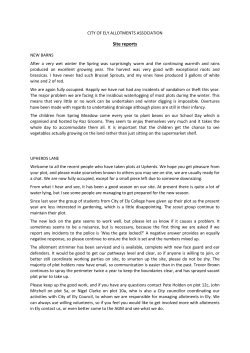
Efficacy of coverboards for sampling small northern snakes
Herpetology Notes, volume 8: 309-314 (2015) (published online on 19 May 2015) Efficacy of coverboards for sampling small northern snakes William Halliday* and Gabriel Blouin-Demers Abstract. Using coverboards to monitor herpetofauna is common practice, yet few studies have formally tested the efficacy of using coverboards. We tested whether using coverboards on survey plots increased the number of small snakes detected in eastern Ontario, Canada. We set up twenty 2500 m2 plots in field and forest habitat, ten with plywood coverboards and ten without coverboards. We sampled these twenty plots systematically for small snakes, and compared the number of snakes detected on plots with coverboards to the number detected on plots without coverboards. The number of snakes detected was always higher on plots with coverboards than on plots without coverboards, to the extent that we only detected the smallest snake species on plots with coverboards. We then examined whether Storeria occipitomaculata in western Québec, Canada prefer plywood or tin coverboards. We set up pairs of plywood and tin coverboards along transects, and monitored the use of these coverboards throughout the active season. Storeria occipitomaculata preferred tin over plywood coverboards. We confirmed that coverboards are indeed a useful tool for monitoring small snakes, and that some snakes show preferences for specific types of coverboards. We therefore suggest that researchers use an array of different types of coverboards when attempting to monitor small snake communities, or determine which coverboards are preferred by their target species in a pilot study. Key words. abundance estimate; monitoring; Common Gartersnake; Dekay’s Brownsnake; Red-bellied Snake; Storeria dekayi; Storeria occipitomaculata; Thamnophis sirtalis Introduction Small terrestrial herpetofauna, including snakes, lizards, and salamanders, are cryptic and are often difficult to detect (Gibbons, 1988). Snakes are often sampled using visual surveys along transects (Diller and Johnson, 1988; Lacki et al., 1994; Bonnet et al., 2002; Luiselli, 2006; Bell et al., 2007), along transects with coverboards (Engelstoft and Ovaska, 2000; Kjoss and Litvaitis, 2001), using drift fences with funnel or pitfall traps (Diller and Johnson, 1988; Grant et al., 1992; Kjoss and Litvaitis, 2001; Bateman et al., 2009), or using arrays of coverboards (Grant et al, 1992; Reading, 1997, 2004; Lelièvre et al., 2013). Coverboards are considered an effective tool for monitoring snakes because snakes are cryptic and spend much of their Department of Biology, University of Ottawa, 30 Marie Curie, Ottawa, ON, Canada, K1N 6N5 * Corresponding author email: whall075@uottawa.ca time in refuges. Coverboards act as refuges, and thus can increase the probability of detecting a snake that would not be seen with a visual survey. In addition, small snakes are difficult to detect in habitats with dense vegetation, therefore in such habitats coverboards might aid in detection of juveniles of large species, and of all age classes of small species. Coverboards are preferable over funnel and pitfall traps due to the potential negative consequences of animals being entrapped (Grant et al., 1992). Different species have different microhabitat preferences that are related to environmental factors such as temperature and moisture. Thus, for any given species, the preferred environmental conditions may be provided by a particular type (Engelstoft and Ovaska, 2000) or size of coverboard (Hecnar and Hecnar, 2011). For example, Engelstoft and Ovaska (2000) found that Contia tenuis preferred asphalt coverboards, Thamnophis elegans and Thamnophis sirtalis preferred asphalt and tin coverboards, and Thamnophis ordinoides showed varied preference; the authors attributed these preferences to the high heat capacity of asphalt and tin coverboards compared to the lower heat capacity 310 William Halliday & Gabriel Blouin-Demers of wood coverboards. Therefore, different types of coverboard may work better for different species. If this information is not known, using various types of coverboards might be the best approach. In this study, we compared the number of snakes detected in survey plots with and without plywood coverboards, and examined the size of snakes that were captured on plots with and without coverboards to determine if coverboards were particularly effective at detecting small snakes. We also examined the preference of Storeria occipitomaculata for plywood versus tin coverboards along transects. Materials and Methods Coverboard use We sampled snakes at the Queen’s University Biological Station (QUBS; 44.5488 N, 76.3668 W; Figure 1) in eastern Ontario, Canada. Although QUBS is home to nine species of snakes, we limited our data analyses to three species with adequate sample sizes: Thamnophis sirtalis (Linnaeus 1758; Common Gartersnake), Storeria dekayi (Holbrook 1836; Dekay’s Brownsnake), and S. occipitomaculata (Storer 1839; Red-bellied Snake). We set up 10 study plots in field habitat matched with 10 adjacent study plots in forest habitat (Figure 1). All of the fields were cut once per year, and were thereby maintained as a mixed grass (Poa spp.) and forb (Trifolium spp. and Viccia spp.) community. All forests were composed mostly of Acer saccharum, Ostrya virginiana, Fagus grandifolia, and Betula papyrifera. All of our plots had an area of 2500 m2. Whenever possible, we attempted to create plots that were 50 × 50 m; however, not all fields were large enough to contain a 50 × 50 m plot, but could instead contain a 25 × 100 m plot. We matched the shape of all forest plots to the shape of their adjacent field plot. We placed eight uniformly spaced plywood coverboards (60 × 60 cm pieces of 0.64 cm plywood) per plot in half of our plots (5 field and 5 forest plots). We sampled each plot at 13h00 each day for three days in a row every two weeks from 5 May to 2 July 2013. We considered each three-day period as one sampling period, for a total of 5 sampling periods throughout the study. During each survey, we systematically walked back and forth across the plots at a constant pace and visually surveyed for snakes, keeping 5 m between subsequent passes across the plot. We simultaneously checked under every coverboard in the plots containing coverboards. We hand-captured each snake that we encountered and gave each individual a unique mark Figure 1. Layout of study plots for sampling small snakes in eastern Ontario, Canada. Coordinates are in WGS 84. by branding its ventral scales using a medical cautery unit (Bovie Aaron Low-Temp Reusable Cautery Unit, Clearwater, Florida; technique and rationale for branding described in Winne et al., 2006). We measured the snout-vent length of each individual and determined its sex. We then released each individual at its point of capture. We compared the number of individual snakes detected for each snake species on plots without coverboards to the number detected on plots with coverboards using linear mixed effects models in R (R Core Team, 2012; package: nlme; function: lme; Pinheiro et al., 2012) with week (temporal replicate), habitat, presence/absence of coverboards, and all interactions as fixed effects, and the plot identity as a random effect to control for spatial autocorrelation. For plots with coverboards, we included all snakes found under coverboards and outside of coverboards. We examined sampling bias based on body size by analysing the snout-vent length (SVL) of T. sirtalis on each plot with and without coverboards in field and forest habitat using multiple linear regression in R (package: stats; function: lm; R Core Team, 2012). We used week, habitat, presence/absence of coverboards, and all interactions as independent variables. We did not examine this potential capture bias for the other two, smaller snake species because they were only captured on plots with coverboards. Efficacy of coverboards for sampling small northern snakes Coverboard preference During the summer of 2014, we set up four 200 m transects in an old field in Pontiac County, Québec, Canada (45.4925 N, 75.9207 W). The plant community in the old field consisted of Poa spp., Ascelpias spp., Solidago spp., and Viccia spp. We placed one pair of tin and plywood coverboards (60 × 60 cm) spaced 1 m apart every 20 m along the transects, for a total of 40 pairs of tin and plywood coverboards. We checked under each coverboard at least three times per week from 21 July to 27 August for a total of 21 sampling days. We captured, measured, marked, and released every S. occipitomaculata that we found, the only species we found regularly. We analysed the number of S. occipitomaculata using each coverboard type on each sampling day of the study using a linear mixed effects model with a Poisson distribution in R (package: lme4; function: lmer; family: poisson; Bates et al. 2012). We used coverboard type (tin or plywood) as a fixed effect, and the sampling day nested within the identity of the pair of coverboards as random effects. We used a Poisson distribution because the data were heavily zero-inflated. Following this analysis, we removed all pairs of coverboards that had zero captures on a day. We then analysed this reduced dataset using a regular linear mixed effects model with the same fixed and random effects as the previous model. 311 The mean SVL of T. sirtalis captured on plots with coverboards was 180 mm shorter than the mean SVL of T. sirtalis caught on plots without coverboards (n = 54 individual snakes, t = 5.03, p < 0.0001), and the mean SVL of T. sirtalis caught in forest habitat was 132 mm longer than the mean SVL of T. sirtalis caught in field habitat (n = 54, t = 2.87, p = 0.006; Figure 3, Table 1). Coverboard preference Storeria occipitomaculata used tin coverboards (37 total captures, 30 unique individuals: 17 marked adults, 2 marked juveniles, 11 unmarked juveniles; Table 2) more than plywood coverboards (4 total captures, 2 uniquely marked adults, 1 unmarked juvenile) according to both the analysis of the full dataset (n = 1680 (21 sampling Results Coverboard use We captured significantly more T. sirtalis on plots with coverboards than on plots without coverboards (n = 100 (20 plots × 5 sampling periods), t = 1.42, p = 0.003; Figure 2, Table 1), and more T. sirtalis in field than in forest habitat. In fact, no snakes were detected in forest habitat on plots without coverboards (cover by habitat interaction: n = 100, t = 2.38, p = 0.02). The number of T. sirtalis detected on plots without coverboards decreased through time, whereas the number detected on plots with coverboards increased through time (plot by week interaction: n = 100, t = 5.24, p < 0.0001). We only captured S. dekayi and S. occipitomaculata in field habitat on plots with coverboards (plot by habitat interaction; S. dekayi: n = 100, t = 3.87, p = 0.0002; S. occipitomaculata: n = 100, t = 2.95, p = 0.004), and the number of individuals detected for these species did not change through time (S. dekayi: n = 100, t = 0.00, p = 1.00; S. occipitomaculata: n = 100, t = 0.00, p = 1.00). Figure 2. The number of individual Common Gartersnakes (Thamnophis sirtalis; T.s.), Dekay’s Brownsnakes (Storeria dekayi; S.d.), and Red-bellied Snakes (Storeria occipitomaculata; S.o.) detected on 2500 m2 study plots in field and forest habitat in eastern Ontario, Canada on plots with or without plywood coverboards. Note that no T. sirtalis were caught on forest plots without coverboards, and S. dekayi and S. occipitomaculata were only caught on field plots with coverboards. Sampling period refers to the three day period that snakes were surveyed every two weeks from 1 May to 2 July 2013. Each point represents the mean value across five study plots during each sampling period, and error bars represent one standard error. 312 1 Table 1. Summary data for snake captures in field and forest plots with and without plywood 2 coverboards in eastern Ontario, Canada. Data are presented as the total number of unique William Halliday & Gabriel Blouin-Demers Table 1. 3Summary data for snake captures in field and forest plots withalland without plywood periods, coverboards in eastern Ontario, individuals captured by species and age/sex class across plots and sampling followed Canada. Data are presented as the total number of unique individuals captured by species and age/sex class across all plots and sampling4periods, followed by the meanlength snout-vent (mm) for that age/sex class. by the mean snout-vent (mm)length for that age/sex class. Treatment Thamnophis sirtalis Storeria dekayi Storeria occipitomaculata Female 12; 419 9; 266 12; 202 Male 14; 352 6; 238 12; 183 Juvenile 30; 276 2; 139 4; 135 Female 2; 512 0 0 Male 2; 416 0 0 Juvenile 0 0 0 Female 5; 555 0 0 Male 4; 421 0 0 0 0 0 0 0 0 Class Field with Cover Forest with Cover Field without Cover Juvenile Forest without Cover 5 days × 80 coverboards), z = 3.97, p < 0.0001) and the analysis of the dataset excluding zeros (n = 66, t = 8.42, p < 0.0001). appear to use forest habitat very little, probably because of thermal constraints (Row and Blouin-Demers, 2006; Halliday and Blouin-Demers, unpublished data). We only found S. dekayi and S. occipitomaculata on field plots with coverboards, likely because of the size Discussion and life history of these species. The longest S. dekayi Population monitoring can be difficult for small, that we captured was 328 mm (SVL) and the longest S. cryptic species such as snakes, yet the use of coverboards occipitomaculata was 253 mm, making them difficult to greatly increased our ability to detect small snakes. In our detect in tall grass. In addition to their small size, both study, we caught S. dekayi and S. occipitomaculata only species are also well camouflaged and spend much of on plots with coverboards, and we caught significantly their time in refuges and hunting for invertebrates at the more T. sirtalis on plots with coverboards than on plots soil-vegetation interface (Rossman and Myer, 1990). without coverboards. In addition, we did not catch any These factors make it particularly difficult to survey snakes in forest habitat on plots without coverboards, these species visually without coverboards. These and only caught a few T. sirtalis on forest plots with factors also apply to T. sirtalis, albeit to a lesser extent, coverboards. These results can be explained by two which may explain why we caught on average smaller T. factors. First, coverboards greatly increased our ability to 1 sirtalis 1 Table 2. Summary data for individual Red-bellied Snakes on (Storeria occipitomaculata) plots with coverboards captured than on plots without detect small snakes. Second, small snakes at our latitude coverboards, and may also explain the decrease in the 2 under tin and plywood coverboards in Pontiac County, Québec. Count is the total number of 3 unique individuals caught throughout the study, and SVL is the mean snout-vent length (mm) of 4 all individuals from that count. Unmarked individuals were newborn individuals that were too Table 2. Summary data for individual Red-bellied Snakes (Storeria occipitomaculata) captured under tin and plywood coverboards in Pontiac5 County, is the number unique individuals the study, and SVL is the mean smallQuébec. to mark,Count therefore thetotal count is theof total number capturedcaught ratherthroughout than the number of unique snout-vent length (mm) of all individuals from that count. Unmarked individuals were newborn individuals that were too small to 6 individuals. mark, therefore the count is the total number captured rather than the number of unique individuals. Tin Cover Plywood Cover 7 8 Female Male Juvenile Unmarked Count 12 5 2 11 Mean SVL 214 191 146 77 Count 0 2 0 1 Mean SVL - 178 - 70 Efficacy of coverboards for sampling small northern snakes number of T. sirtalis detected on plots without covers as the season progressed. Our ability to detect T. sirtalis probably decreased on plots without coverboards as the season progressed because of increased vegetation height. Although vegetation height also increased on our plots with coverboards and decreased our ability to detect snakes outside of the coverboards, the presence of coverboards allowed us to continue catching snakes as the season progressed. This size bias related to sampling technique has been observed in other snake species (Prior et al., 2001; Willson et al., 2008). An alternative explanation for the temporal variation in captures could be that in late June and in early July temperatures were too hot for snakes at 13h00. Snakes seeking shelter to escape the heat would be more attracted to our coverboard plots than to our plots without coverboards. Although we used plywood coverboards on our plots, other researchers have found that using tin coverboards or roofing shingles is more effective for attracting snakes (e.g., Engelstoft and Ovaska, 2000; Figure 3. The snout-vent length of Common Gartersnakes (Thamnophis sirtalis) on 2500 m2 study plots in field and forest habitat in eastern Ontario, Canada on plots sampled with or without plywood coverboards. Note that no snakes were caught on forest plots without coverboards. Sampling period refers to the three day period that snakes were surveyed every two weeks from 1 May to 2 July 2013. Each point represents the mean value across all captured individuals during each sampling period, and error bars represent one standard error. Points without error bars represent a single individual. 313 Hampton, 2007). Indeed, our transects with plywood and tin coverboards confirmed that S. occipitomaculata prefer tin over plywood coverboards. Future studies should attempt to determine whether a specific type of coverboard is better for attracting all snake species, or whether different snake species (or age classes within species) prefer different types of coverboards. A key factor determining the attractiveness of coverboards is probably the degree to which they match the thermal environment favoured by the species (Lelièvre et al., 2010). For similar reasons, the size of coverboards may also be important to snakes: small coverboards may get too hot and large coverboards may not get warm enough, similar to the pattern observed for natural cover objects (Quirt et al., 2006; Hecnar and Hecnar, 2011). Another way to increase the number of individuals detected would be to increase the number of coverboards (Reading, 1997). The rationale behind using coverboards is to provide artificial refuges that can be more easily monitored than natural refuges. By increasing the number of coverboards, researchers could increase their ability to find snakes. Future research could manipulate the number of coverboards within a plot to see if an increase in the number of coverboards increases the number of snakes detected. We recommend that researchers attempting to monitor communities of small terrestrial snakes use an array of coverboards (Reading, 1997) of different types (material, thickness, and size) to maximize the number of species detected until it has been established whether one type of coverboard is universally superior to the other types of coverboards for attracting small snakes. If the goal is to detect and monitor a particular species, the first step should be to determine the coverboard preference of that species, keeping in mind there may be seasonal variation in preference due to changing environmental conditions, and then to use the preferred type of coverboard to increase the number of individuals detected. Acknowledgements. We thank J. Châteauvert, P. Fassina, L. Halliday, S. Karabatsos, Z. Maillet, and M. Routh for assistance in the field, Queen’s University Biological Station for providing logistical support, and the Nature Conservancy of Canada for the use of their property in Québec. This research was funded by the University of Ottawa, an Ontario Graduate Scholarship and a Natural Science and Engineering Research Council (NSERC) of Canada Post-Graduate Scholarship to WDH, and an NSERC Discovery Grant to GBD. All research was approved by the University of Ottawa Animal Care Committee, which follows the guidelines of the Canadian Council on Animal Care. 314 References Bateman, H.L., Chung-MacCoubrey, A., Snell, H.L., Finch, D.M. (2009): Abundance and species richness of snakes along the middle Rio Grande Riparian Forest in New Mexico. Herpetological Conservation and Biology 4: 1–8. Bates, D., Maechler, M., Bolker, B. (2012): lme4: linear mixedeffects models using S4 classes. R package version 0.999999-0. Bell, S.L.M., Herman, T.B., Wassersug, R.J. (2007): Ecology of Thamnophis sauritus (eastern ribbon snake) at the northern limit of its range. Northeastern Naturalist 14: 279–292. Bonnet, X., Pearson, D., Ladyman, M., Lourdais, O., Bradshaw, D. (2002): ‘Heaven’ for serpents? A mark-recapture study of tiger snakes (Notechis scutatus) on Carnac Island, Western Australia. Austral Ecology 27: 442–450. Diller, L.B., Johnson, D.R. (1988): Food habits, consumption rates, and predation rates of western rattlesnakes and gopher snakes in Southwestern Idaho. Herpetologica 44: 228–233. Engelstoft, C., Ovaska, K.E. (2000): Artificial cover-objects as a method for sampling snakes (Contia tenuis and Thamnophis spp.) in British Columbia. Northwestern Naturalist 81: 35–43. Gibbons, J.W. (1988): The management of amphibians, reptiles and small mammals in North America: the need for an environmental attitude adjustment. In: Management of Amphibians, Reptiles, and Small Mammals in North America. United States Forest Service General Technical Report RM-166, p. 4–10. Szaro, R.C., Severson, K.E., Patton, R., Eds., Colorado, USA, Ft. Collins. Grant, B.W., Tucker, A.D., Lovich, J.E., Mills, A.M., Dixon, P.M., Gibbons, J.W. (1992): The use of coverboards in estimating patterns of reptile and amphibian biodiversity. In: Wildlife 2001: Populations, p. 379–403. McCullough, D.R., Barrett, R.H., Eds., Netherlands, Springer. Hampton, P. (2007): A comparison of artificial cover types for capturing amphibians and reptiles. Amphibia-Reptilia 28: 433– 437. Hecnar, S.J., Hecnar, D.R. (2011): Microhabitat selection of woody debris by Dekay’s brownsnake (Storeria dekayi) in a dune habitat in Ontario, Canada. Journal of Herpetology 45: 478–483. Kjoss, V.A., Litvaitis, J.A. (2001): Comparison of 2 methods to sample snake communities in early successional habitats. Wildlife Society Bulletin 29: 153–157. Lacki, M.J., Hummer, J.W., Fitzgerald, J.L. (1994): Application of line transects for estimating population density of the endangered copperbelly water snake in Southern Indiana. Journal of Herpetology 28: 241–245. Lelièvre, H., Blouin-Demers, G., Bonnet, X., Lourdais, O. (2010): Thermal benefits of artificial shelters in snakes: a radiotelemetric study of two sympatric colubrids. Journal of Thermal Biology 35: 324–331. Lelièvre, H., Rivalan, P., Delmas, V., Ballouard, J.M., Bonnet, X., Blouin-Demers, G., Lourdais, O. (2013): The thermoregulatory strategy of two sympatric colubrid snakes affects their demography. Population Ecology 55: 585–593. Luiselli, L. (2006): Site occupancy and density of sympatric Gaboon viper (Bitis gabonica) and nose-horned viper (Bitis nasicornis). Journal of Tropical Ecology 22: 555–564. Pinheiro, J., Bates, D., DebRoy, S., Sarkar, D., R Core Team. William Halliday & Gabriel Blouin-Demers (2012): nlme: linear and nonlinear mixed effects models. R package version 3.1–106. Prior, K.A., Blouin-Demers, G., Weatherhead, P.J. (2001): Sampling biases in demographic analyses of black rat snakes (Elaphe obsoleta). Herpetologica 57: 460–469. Quirt, K.C., Blouin-Demers, G., Howes, B.J., Lougheed, S.C. (2006): Microhabitat selection of five-lined skinks in northern peripheral populations. Journal of Herpetology 40: 335–342. R Core Team. (2012): R: a language and environment for statistical computing. R Foundation for Statistical Computing, Vienna, Austria. ISBN 3-900051-07-0. url: http://www.R-project.org/. Access 25 January 2014. Reading, C.J. (1997): A proposed standard method for surveying reptiles on dry lowland heath. Journal of Applied Ecology 34: 1057–1069. Reading, C.J. (2004): The influence of body condition and prey availability on female breeding success in the smooth snake (Coronella austriaca Laurenti). Journal of Zoology 264: 61– 67. Rossman, D.A., Myer, P.A. (1990): Behavioral and morphological adaptations for snail extraction in the North American brown snakes (Genus Storeria). Journal of Herpetology 24: 434–438. Row, J.R., Blouin-Demers, G. (2006): Thermal quality influences effectiveness of thermoregulation, habitat use, and behaviour in milk snakes. Oecologia 148: 1–11. Willson, J.D., Winne, C.T., Keck, M.B. (2008): Empirical tests of biased body size distributions in aquatic snake captures. Copeia 2008: 401–408. Winne, C.T., Willson, J.D., Andrews, K.M., Reed, R.N. (2006): Efficacy of marking snakes with disposable medical cautery units. Herpetological Review 37: 52–54. Accepted by Christoph Liedtke
© Copyright 2025









